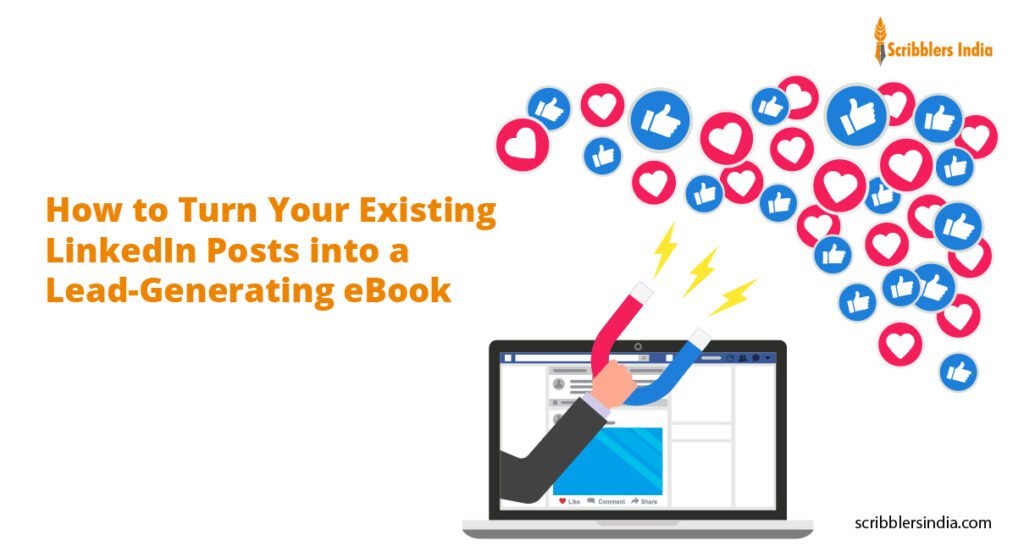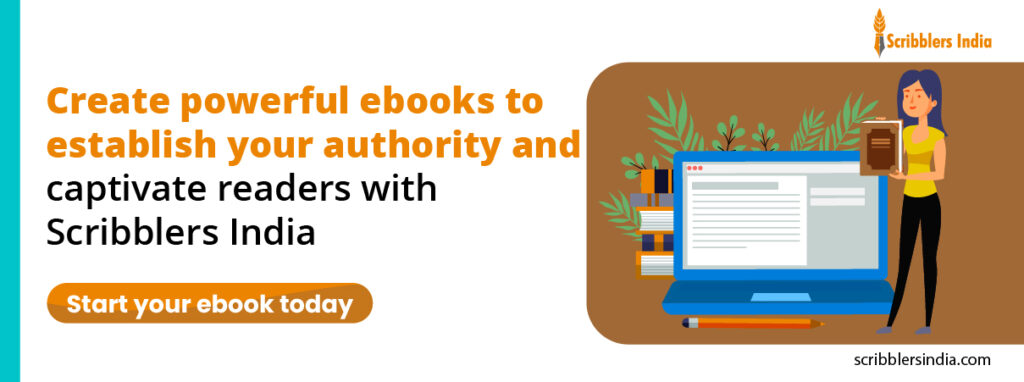You are likely sitting on a digital goldmine without realizing it. You have spent months, perhaps even years, crafting thought leadership posts that resonated with your LinkedIn network. These posts received excellent engagement for forty-eight hours, only to disappear into the algorithmic abyss forever. It is frustrating to see valuable intellectual property vanish so quickly. Consider compiling those LinkedIn posts into an ebook to preserve and share your insights.
You know you need a permanent lead magnet, like a professionally written eBook, to capture email addresses and build deeper trust with prospects. However, the thought of writing five thousand new words from scratch probably feels impossible with your current executive schedule. The good news is that you do not have to start from a blank page.
According to recent research, 61 % of B2B marketers say their content-strategy effectiveness improved in the past year. You can tap into this momentum by turning your LinkedIn posts into an ebook that works for you around the clock. This process allows you to “excavate” your own feed and package your best insights into a cohesive asset. In this guide, we will show you the exact auditing, organizing, and polishing process to transform scattered social media updates into an authoritative book that generates leads on autopilot.
Why Should You Turn LinkedIn Posts into an Ebook?
You should turn LinkedIn posts into an ebook because it creates a permanent business asset from fleeting social media content. This process deepens audience trust by providing substantial value while significantly reducing the time required to create a high-quality lead magnet from scratch.
- Deepening Trust with Your Audience: A standard LinkedIn post is a snack, while a well-written eBook is a full meal. By offering long-form content, you prove to your prospects that you have depth and substantive expertise beyond the character limit of a social media update.
- Creating a “Forever” Asset: Social media posts have a disturbingly short lifespan, often becoming irrelevant within two days. An eBook is an evergreen asset that can continue to educate your audience and build your reputation for years after its initial creation.
- Gaining Lead Capture Capability: You cannot “gate” a LinkedIn post to ask for contact information. You can, however, require an email address to download your eBook, instantly turning anonymous readers into reachable leads for your sales team.
- Achieving Maximum Efficiency: Writing a book from scratch is a daunting task that often leads to procrastination. When you turn LinkedIn posts into an ebook, nearly 60% of the hard work is already done, making completion far more realistic.
How Do I Choose The Right Posts For My Ebook?
To choose the right posts when you turn LinkedIn posts into an ebook, focus on high-engagement content that addresses enduring problems. You must conduct a ruthless audit of your past activity to find distinct patterns and themes rather than selecting random successful updates.
Look for your “Greatest Hits”
Start by using your LinkedIn analytics to identify your top 20-performing posts from the last year. High engagement usually indicates high resonance with your target audience, making these posts ideal candidates for your core chapters.
Identify recurring thematic patterns
Do not merely grab random posts that performed well. Look for clear patterns in your writing. If you have written fifteen times about “remote work culture challenges,” you have found the central theme for your new book.
Ignore highly time-specific content
You must leave out posts that comment on fleeting news events or temporary trends. Your eBook needs to be “evergreen” to remain relevant for a long time, so focus on timeless principles rather than passing fads.
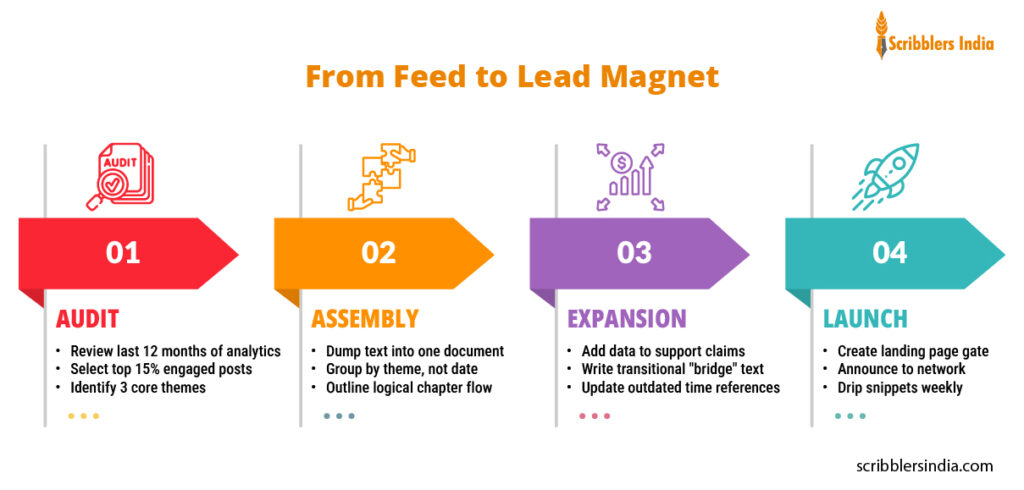
What Tools Can Help Me Turn LinkedIn Posts Into An eBook Faster?
The best tools to help you turn LinkedIn posts into an ebook efficiently are simple ones you likely already use. You need basic analytics software to identify your best content and a robust word processor to organize and expand that content into a manuscript.
- Analytics for Content Auditing: Use LinkedIn’s native analytics or third-party tools like Shield to sort your entire posting history by engagement rate quickly. This data-driven approach removes guesswork when deciding which topics your audience truly cares about. After all, 65% of B2B marketers say content relevance and quality are the top performance drivers.
- Organizational Writing Platforms: Standard tools like Google Docs work well for the initial “dump and sort” phase. For more complex structures, software like Scrivener can help you drag and drop different posts into various chapters to test different flows.
- Transcription Services for Expansion: If you prefer speaking over typing, use tools like Otter.ai. You can read your old post out loud and then verbally riff on it for ten minutes to generate the new content needed for a full chapter.
What Are The Steps To Convert Scattered Posts Into Chapters?
The steps to turn LinkedIn posts into an ebook involve gathering your raw materials, organizing them logically, and then significantly expanding them. You must move beyond simple copy-pasting to ensure the final product reads like a cohesive book rather than a disjointed collection of old updates.
Step 1: The “Dump and Sort” Method
Begin by copying every relevant post you identified during your audit into a single massive document. Do not worry about the order at this stage; your only goal now is to get the raw text off LinkedIn and into a workable format.
Step 2: Create a Logical Flow
Arrange your posts by theme rather than chronological order. Group them into a logical narrative arc: general philosophy at the beginning, specific tactical advice in the middle, and relevant case studies or future predictions at the end.
Step 3: Expanding the “Meat”
LinkedIn forces brevity, but books require depth. You must now add the context you originally cut out to save space. Add concrete examples, supporting data, and deeper explanations to flesh out each original post into a full chapter.
Step 4: Writing the Bridges
You need smooth transitions to ensure a good reading experience. It is not advisable to simply paste five different posts together and call it a chapter. You must write connective paragraphs that link the idea from one post seamlessly to the next.
How Strictly Should I Stick To The Original Posts?
You should not stick strictly to the original posts when you turn LinkedIn posts into an ebook. Treat your old posts as detailed outlines or rough drafts rather than final sacred text that cannot be altered for the new format.
- Adapt for the New Medium: Remember that what works on a mobile feed often reads poorly in a PDF. You will likely need to combine several short, punchy posts into a single, longer paragraphs to create a more comfortable reading experience for long-form consumption.
- Update Outdated References: Ensure you remove any language that anchors the text to a specific past date. Phrases like “as I said last week” or “in today’s news” will immediately date your book and should be removed or updated during the editing phase.
- Feel Free to Rewrite Completely: Sometimes a post provides a great core idea, but the original execution does not fit your book’s tone. Give yourself permission to rewrite the entire concept from scratch using the original post merely as a conceptual prompt.
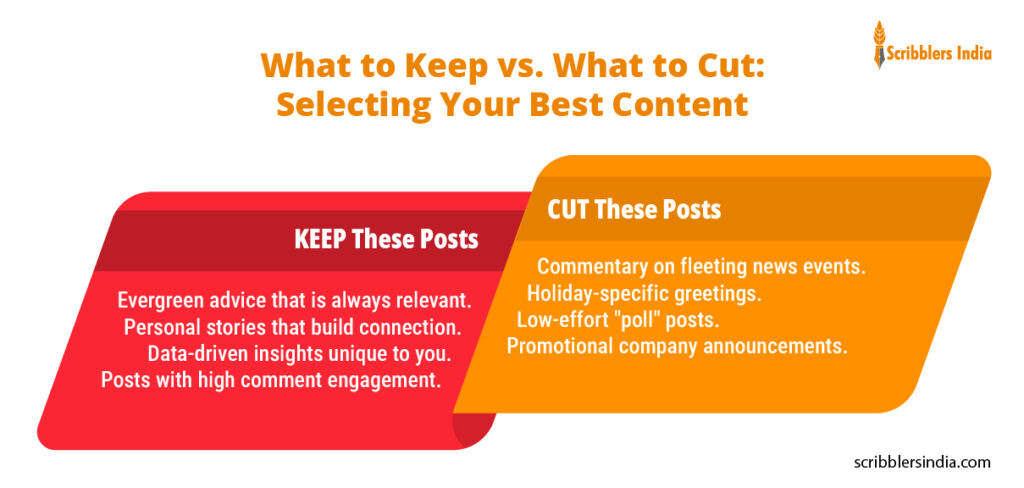
How Do I Ensure the eBook Actually Generates Leads?
To ensure your eBook generates leads, you must integrate eBook lead generation strategy elements directly into the text. It is not enough to just have good content; the book itself must be engineered as a marketing tool that guides readers toward your paid services.
The “Upgrade” Call to Action (CTA)
Do not wait until the last page to ask for business. Include relevant links to your services or calendar booking page within the chapters themselves, specifically where you discuss solving the problems your services address.
The Irresistible Benefit-Driven Title
Avoid generic titles like “My LinkedIn Posts from 2024.” Choose a title that promises a specific outcome, such as “The Modern CEO’s Guide to Remote Culture: Practical Strategies Based on Real-World Data.”
A Simple Gating Strategy
Decide where your book will live online. A simple landing page that requires a name and email address to download the file is standard. Ensure the landing page copy clearly articulates the value of downloading the book.
How Do I Promote My Ebook Once It Is Finished?
Promoting your eBook requires leveraging the same LinkedIn thought leadership strategy that helped you create it. You must use your active presence on the platform to consistently drive traffic to your new lead magnet over an extended period.
The “Launch” LinkedIn Post
Write a dedicated new post announcing the book’s release. Publicly thank your audience for inspiring the content with their previous engagement. This makes them feel involved in the process and more likely to download it.
The “Drip” Content Strategy
Do not just post about your book once. For the next few weeks, share small, valuable snippets or interesting quotes from the book. Always include a link to the download page in the comments section.
Direct and Personal Outreach
Send the book personally to high-value prospects you have already been chatting with. A message like “I wrote this and thought of our last conversation” is a highly effective way to restart a stalled sales discussion.
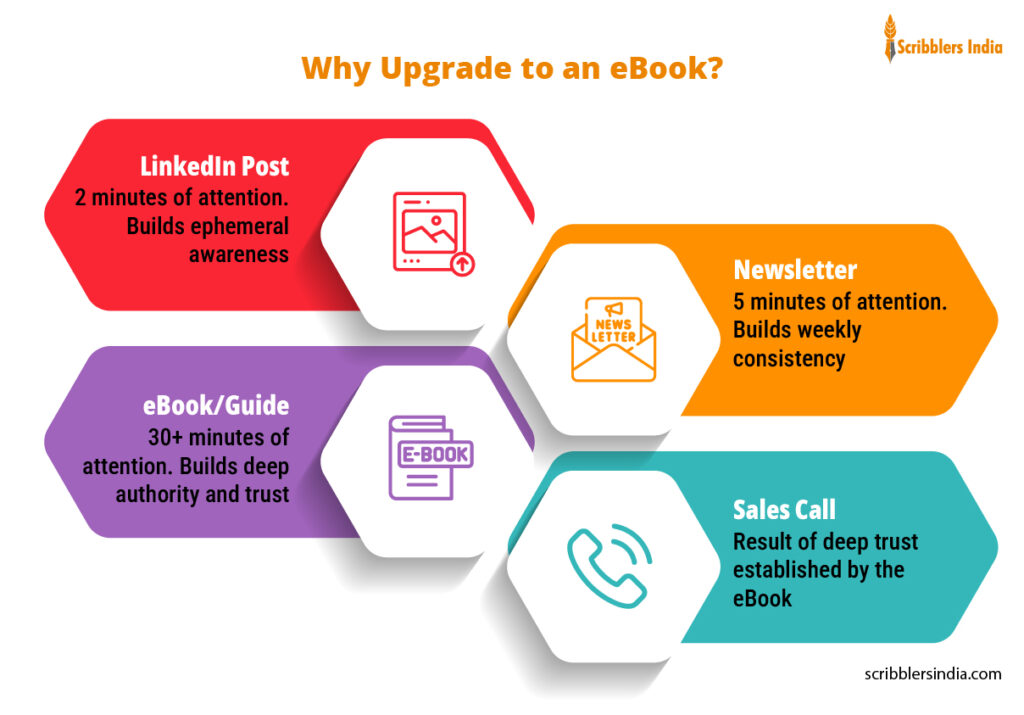
What Mistakes Should I Avoid When Repurposing Content?
When you turn LinkedIn posts into an ebook, avoid the mistake of simply pasting text without review. This creates a low-quality “Frankenstein” product that can actually damage your personal brand reputation, rather than enhancing it. As a result, your content can appear lazy and unprofessional.
- The “Frankenstein” Monster: merely pasting posts together without editing them for flow feels disjointed and lazy to the reader.
- Forgetting to Update: Leaving in old references (e.g., “As I said last week…”) that don’t make sense in a book format long after the fact.
- Over-Gating the Download: Asking for too much information to download it. Name and email are enough; asking for phone numbers might scare people away.
- Ignoring Platform Context: Failing to adapt the tone from casual social media campaigns to a more structured eBook format can jar the reader.
- Neglecting a Final Proofread: Typos that are often forgiven on social media look unprofessional in a supposedly polished eBook.
Why You Need Ghostwriting Services in India
You might have the raw content, but you might lack the time to stitch it all together. Perhaps you need fresh chapters written to fill the gaps in your narrative. This is where professional help changes the game.
India has become a premier global hub for high-level professional eBook ghostwriting, offering a perfect blend of elite proficiency and rational pricing. Scribblers India stands at the forefront of this specialized industry.
Global Quality, Sensible Economics
We provide UK and US-level editorial standards without the inflated agency fees often seen in Western markets. You receive premium content repurposing for leads that fits your budget without ever compromising on the final quality.
Native-Level English Proficiency
Our team comprises career writers who understand nuance, idioms, and sophisticated professional tone. We craft it persuasively to ensure your book reads as if a native industry expert wrote it.
Cultural and Executive Adaptability
We work with global C-suite leaders daily and know how to adjust tone from Silicon Valley casual to London boardroom formal. Our experts can curate content depending on who you need your book to impress.
The “Full-Stack” Approach
We do not just write; we handle the entire process for you. We can audit your LinkedIn feed, structure the manuscript, write the necessary bridges, and provide the final polish so you can turn LinkedIn posts into an ebook effortlessly.
Speed without Sacrifice
Leveraging time zone differences can work in your favor. We often work while you sleep, delivering faster turnarounds than local alternatives. This allows you to get your lead magnet into the market sooner.
Are you ready to turn your scattered thoughts into a cohesive revenue-generating asset? Contact Scribblers India today and let us turn your feed into your fortune.
Frequently Asked Questions (FAQs)
How many LinkedIn posts do I need to make an ebook?
Typically, fifteen to twenty high-quality posts can form the strong backbone of a solid 3,000-word eBook. Once these posts are expanded with necessary context, data, and transitional paragraphs, they create a substantial resource.
Is it okay to reuse content people have already seen?
Absolutely. Most of your audience likely missed the post the first time due to the algorithm. Those who did see it will appreciate having your best thoughts organized in one convenient and searchable place.
Do I need a fancy design for my ebook?
Clean and professional formatting is enough for most B2B eBooks. You do not need expensive custom art, but the document must be readable, branded with your colors, and free of layout errors.
Should I charge money for this ebook?
Generally, no. If your primary goal is lead generation, an email address is far more valuable to your long-term business than a small one-time payment. Use it as a free tool to build your list.
Can you write it from scratch if I lack posts?
Yes. If you do not have enough existing content to turn LinkedIn posts into an ebook, an expert ghostwriting service provider can interview you to extract your ideas and write the book from the ground up.

